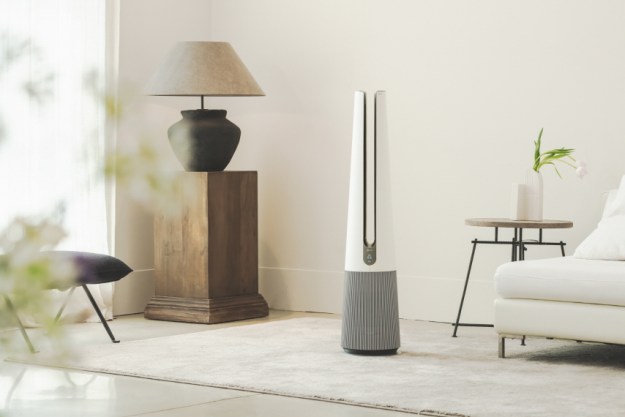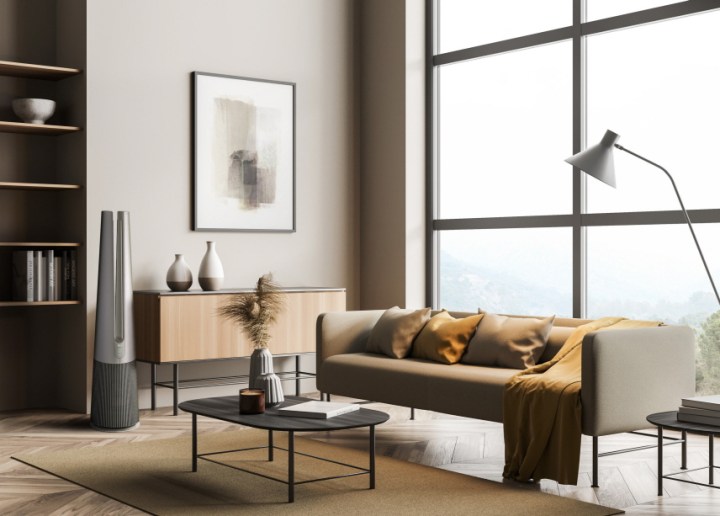
“The LG PuriCare AeroTower is a glimpse at what future air purifiers should be: Multifunctional and more than an afterthought.”
- Quiet
- Efficient purification
- Multiple cooling modes and fan speeds
- 10-year warranty on the motor
- No heating capabilities
Indoor air quality is important, but I often find myself wishing air purifiers could also adjust the temperature of the air. After all, while stagnant air might feel musty, it’s also a lot warmer than moving air — and that’s the last thing I want on a humid summer day.

The $600 LG PuriCare AeroTower turned out to be almost exactly what I was looking for. Not only does it do a great job at improving air quality, but it doubles as an oscillating fan. The upstairs loft in my apartment is about five degrees warmer than the rest of the house on average, but keeping the AeroTower up there keeps it just as comfortable as anywhere else in my home.
Installation and setup
The PuriCare AeroTower comes in a big box, and I had to lay it sideways to slide all the components out. The good news is that it’s mostly fully assembled when it arrives, so it’s just a matter of setting it up where you want it.
Despite its size, the entire device is only 27.6 pounds. It’s not too heavy by any means, but it is pretty large. It’s 10.4 inches in diameter, 44.1 inches tall, and needs sufficient vertical and horizontal clearance. If you place it in a tight space, it won’t work as well.
Setup mostly consists of pulling out the filter and removing the protective plastic. You also have to remove tape from the fan blades that run up the AeroTower.
Adding it to the LG app is equally as simple — just tap Add a Device, select it from those available, and follow the on-screen instructions. You might be required to press and hold the Wi-Fi button on the air purifier itself, but it was one of the easiest pairings I’ve dealt with in a while.
Features and operation
Once plugged in, the PuriCare AeroTower will start working right away. An onboard display shows the current fan speed, the air quality, and any status alerts you need to be aware of (like when to swap out the filter).
One nifty feature is the remote control that comes with the AeroTower. It has a magnetic mount that makes it easy to keep track of it; just hang it on the side of the purifier when you’re done. It gives you the same controls you can access through the app, just in physical form — which makes it a bit easier to control for the less tech-savvy.
You can control the fan speed, rotation, and sleep timer, and activate Turbo Mode (which just sets the fan to maximum speed) from the remote. You can also set a sleep timer and adjust the display brightness, which is ideal for use in bedrooms.

There are three airflow options to choose from: Direct, Wide, and Diffused.
Direct Mode propels the air forward from where the fan faces. This is ideal for cooling yourself off in a hot room, and the mode I used most often in testing.
Wide Mode works in a similar way to Direct, but it spreads the air across a wider area.
Diffused Mode expels air through the top of the machine and spreads it around a room. If you want to use the AeroTower in a more centralized location in a room, Diffused Mode is the best pick.
There are also 10 fan speeds. I found that speed six is about the perfect balance between airflow and volume level. Each is slightly louder than the previous level, but it’s not nearly as loud as other air purifiers I’ve used. If you activate Turbo Mode, it basically sets it to speed 10 for a limited time, then swaps back to Auto Fan — which adjusts the speed and filtration level based on the air quality.
Air quality readings
One area the LG PuriCare AeroTower excels is measuring and purifying the air. It has four different color-coordinated ratings for your air quality based on particulate matter (PM).
Red means the air quality is poor, which translates to a PM10 of 255 or more, a PM2.5 of 56 or more, and a PM1.0 of 56 or more.
Orange means the air quality is unhealthy, which means a PM10 of 155 to 254, a PM2.5 of 35 to 55, and a PM1.0 of 36-55.
Yellow means the air quality is moderate, with a PM10 of 55 to 154, and a PM2.5 and PM1.0 of 13 to 35.
Green is what you want to aim for. This means the air quality is good, with a PM10 of 54 or less and a PM2.5 and PM1.0 of 12 or less.
The air quality sensor is sophisticated and notes even small changes in air quality; for example, walking by it after spritzing cologne shifted the air quality temporarily. When I first set up the PuriCare AeroTower, my air quality read as unhealthy for two days. Since then, it’s remained in the green zone (as long as I leave the AeroTower on, anyway).
The AeroTower is a remote worker’s best friend.
The UVnano tech in the AeroTower is a lifesaver. While some air purifiers can get a bit gross — one of the reasons to swap the filter — the AeroTower uses UV light to clean the fan blades of any bacterial backpackers. It works without drawing much attention to itself, but keeps your air purifier free of any odor-causing bacteria.
Day-to-day use
I’m fond of smart devices that I can set up and then forget about. The LG PuriCare AeroTower is exactly that — once I set it up and found my preferred fan speed and rotating style, I haven’t touched it since. It steadily hums away and cleans the air all day long. Most importantly, it doesn’t distract me.
I’ve tested air purifiers in the past that were obnoxiously loud, even on lower settings. The AeroTower is a remote worker’s best friend, especially if you share a home office with your spouse. If they get cold easily and prefer to keep the overhead fan off, the AeroTower can keep you cool without bothering them.
The loft has always been a little bit warmer than the rest of my home, but the LG PuriCare AeroTower keeps it cool and comfortable.
It connects with the LG ThinQ app. You can use the app like a controller to change the mode, the fan speed, rotation, and more. You can even adjust the brightness of the display from the app, or turn UVnano tech on and off.
Like I said, I don’t tinker with my settings much. I do find myself checking the app to see what the current temperature in my loft is, as well as the relative humidity level. The loft has always been a little bit warmer than the rest of my home — sometimes unpleasantly so — but the LG PuriCare AeroTower keeps it cool and comfortable.
Our take
The LG PuriCare AeroTower is a two-in-one smart device with a lot of innovative, thoughtful features — and it’s by far the best air purifier I have ever tested.
Is there a better alternative?
The only other device on the market that comes close to the LG PuriCare AeroTower would be the Dyson Pure Hot + Cool. It has many of the same features, but can also warm the air — something the AeroTower can’t yet do.
How long will it last?
The motor powering the rotation and the fan has an estimated life of 10 years, as well as a 10-year warranty. All other components have a one-year warranty. As for how long it will last, my guess is a long time. Great build quality means it will keep chugging away for years to come.
Should I buy it?
Absolutely. While it is pricy at $600, the feature list more than makes up for it, as does its performance. It purifies 818 square feet, and I would happily get a second one for my home.
Editors' Recommendations
- Best washer and dryer deals: bundles from LG, Samsung and more
- The best air purifiers for mold, selected by experts
- Do air purifiers work?
- 10 tips to make the most of your air purifier
- Can you run an air purifier and essential oil diffuser at the same time?





